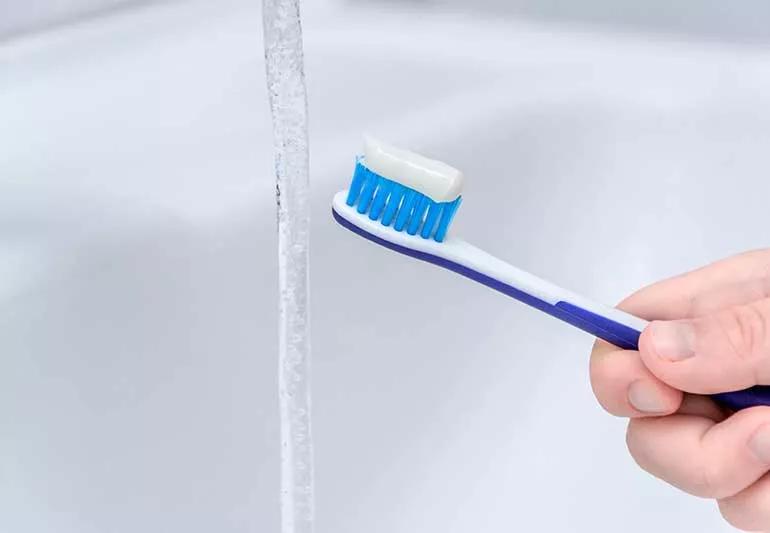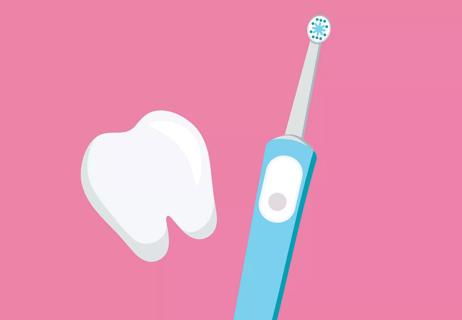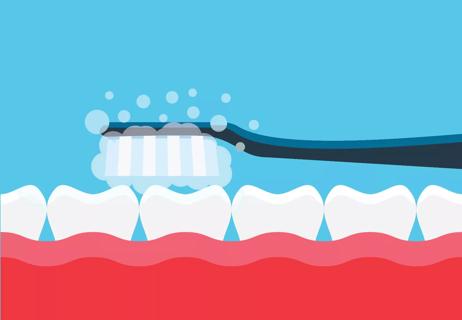Despite unfounded theories, fluoride has the power to make your teeth stronger

If you were to walk into a dentist’s office, you might find a great divide between people who are against the use of fluoride treatments and those who wish to have them.
Advertisement
Cleveland Clinic is a non-profit academic medical center. Advertising on our site helps support our mission. We do not endorse non-Cleveland Clinic products or services. Policy
But many of the arguments against fluoride are rooted in a fear of how it was first discovered and later introduced into the United States’ water supply. Coupled with the fact that fluoride is most beneficial during a child’s early and adolescent developmental stages, the question of whether or not fluoride is good for you and your kids comes up quite often.
Dentist Nathan Janowicz, DMD, cracks the code on fluoride and its somewhat complicated history, as well as how it’s used today.
A quick internet search will unveil many conspiracy theories around fluoride and how it worked its way into our water supply in the U.S. From lowering IQs and causing brain damage to the government’s way of mind-controlling the masses, there are a lot of theories to sift through. But at the core of every one of them, you’ll find a real fear that fluoride could be poisonous.
“Some people request not to have fluoride treatments when they come in for their routine dental care out of fear that fluoride is going to cause harm to their body,” says Dr. Janowicz. “But like anything, even things that are made naturally in your body, fluoride is fine, good and recommended in small quantities.”
It’s true you can have too much fluoride, but in most cases, it causes unwanted cosmetic issues that we’ll address here in a moment. But according to the American Dental Association, for someone to experience true fluoride toxicity with serious or life-threatening illness, it would take drinking 5 liters of water for every kilogram of body weight. For an adult at 155 pounds, that means you’d have to drink roughly 120 gallons of water at once.
Advertisement
“You would have to drink so much water, you would die of drinking too much water before you would die of over-fluoridation,” states Dr. Janowicz.
The national recommended allowance for fluoride in drinking water is .7 milligrams per liter. If you have a well water system, you want to make sure you’re keeping up with annual tests to ensure your water quality is up to par. But for 73% of the U.S., that job is already done for them.
So, how did we get here, and why do people have the misconception that they’ve been duped about the benefits of fluoride?
According to the U.S. Centers for Disease Control and Prevention, the history of fluoridated public water got its start all the way back in 1901 when a Colorado dentist started noticing an unusual brown stain, or mottled enamel, on the teeth of several of his patients. Those same teeth, though stained, were somehow less vulnerable to cavities and decay. The suspected root cause of their condition was some unknown substance in the local water supply.
By 1942, dentists had identified the cause of mottled enamel as fluorosis, or an over-exposure to high amounts of fluoride during developmental years as children. But because of its cavity-resistant qualities, fluoride seemed like it could be a beneficial ingredient in water supplies as long as it could be controlled at low concentrations so it wouldn’t lead to fluorosis.
In 1945, this theory was put to the test by adjusting the fluoride level to safe amounts in the public water supplies of eight cities across Michigan, New York, Illinois and Ontario, Canada. As you’d expect, there were some misgivings about fluoride because so much had been previously unknown about the element and because these eight cities were used for a trial run to see just how healthy it might be if it were controlled.
But over the course of 13 to 15 years, cavities among children in those communities were reduced by 50% to 70%, proving that fluoridation worked to slow down or stop tooth decay.
By 1962, water fluoridation had become widely used across the U.S. because of the benefits of fluoride. That continues to remain true today.
“Fluoridation is one of the easiest ways to prevent decay in a community at large,” notes Dr. Janowicz. “By fluoridating our water supply, we can address a public health issue at the source instead of getting everyone into a clinic to fluoridate them individually.”
A breeding ground for bacteria, acid and saliva, your mouth is in a constant state of natural decay and repair. Some of the bacteria living in your mouth create acid as they feast on leftover food and drink you ingest throughout the day. That acid then builds up in your mouth and removes important minerals from your enamel, the protective outer layer of your teeth. To replace what’s lost, your body removes calcium and phosphates from your saliva and deposits them in your enamel to keep your teeth protected.
Advertisement
So, where does fluoride help in this process? Well, there are two kinds of fluoride:
Both kinds of fluoride work in different ways but have the following benefits:
When you use topical fluoride, it’s absorbed by the enamel of your teeth. This fluoride is stronger than the initial minerals lost because of acid and bacterial buildup.
“We put a fluoride varnish on teeth after cleaning visits, and that’s not ingested,” says Dr. Janowicz. “It just sits on your tooth surface and absorbs into the tooth to prevent local cavities.”
Systemic fluoride, leftover from drinking water and other foods, sits in your saliva, which constantly bathes your teeth throughout the day. This systemic fluoride acts as a coating similar to topical fluoride. More importantly, systemic fluoride gets incorporated into the actual structure of your teeth as they’re developing from the age of 6 months to 16 years.
“The fluoride that’s ingested is beneficial for adolescents and kids as their adult teeth develop because that’s where it actually incorporates into the developing tooth,” Dr. Janowicz adds.
Advertisement
If you don’t brush or floss your teeth, the combination of bacteria, acid and saliva forms a sticky film called plaque along the surface of your teeth. That plaque, which eventually hardens and turns into hard-to-remove tartar, causes concentrated tooth decay, or permanent damage, in the form of tiny holes, fissures or lesions called cavities, over time.
That’s why it’s important to brush your teeth twice a day. And if you use a toothpaste or mouth rinse that has fluoride in it, you’re not only clearing your enamel of any existing cavity-causing bacteria, but you’re strengthening your teeth as well.
“If you continue to hit your teeth with fluoride, they will maintain their strength, but if you stop using the topical fluoride over time, it will be less effective,” cautions Dr. Janowicz. “Once a cavity is to the point of needing treatment, it’s far too late for fluoride or any other thing to reverse that cavity.”
The core cause of cavities is all that acid that sits in plaque. If your teeth have a strong foundation because of systemic fluoride and a strong outer layer from topical fluoride, you have twice the protection needed to stop that acid in its tracks before it creates cavities or causes unwanted sensitivity in your teeth.
Advertisement
“When fluoride gets absorbed into the tooth, it makes it more resistant to acid erosion as well as decay,” says Dr. Janowicz.
Drinking fluoridated water is good, especially for kids 3 to 16 whose teeth are still developing and need that systemic fluoride. As an extra measure, Dr. Janowicz advises fluoride treatments during six-month cleaning appointments for kids 3 to 16 and adults with cavities or sensitivity issues.
“For people who’ve had radiation or a condition like Sjogren’s syndrome that causes dry mouth and makes them more susceptible to decay, we can make trays that they put fluoride gel in at night to help fortify their teeth to protect them against decay,” explains Dr. Janowicz. “You can get fluoride in your over-the-counter toothpaste and mouth rinses with fluoride in them, and we also have prescription-strength fluoride gels, toothpaste and mouth rinses to help prevent decay in high-risk populations.”
In general, Dr. Janowicz recommends brushing with a fluoride toothpaste twice a day and using a mouth rinse with fluoride once a day. He recommends the same treatment for kids old enough to swish mouth rinses without swallowing, typically 6 and up.
“There are a lot of DIY alternatives to fluoride floating around online, but nothing has been clinically proven to strengthen your teeth or be a true fluoride alternative.”
Learn more about our editorial process.
Advertisement

You might have a sensitive gag reflex — but gagging while brushing can also be a result of certain medical conditions

An old, worn toothbrush is a hazard to your teeth and gums and a breeding ground for germs and bacteria — replace it every three to four months at least

Done correctly, daily flossing can help keep your teeth and gums healthy

Bloody gums after flossing usually signal a buildup of plaque, tartar and bacteria

A variety of products can be effective at removing stains on teeth

Studies show they do a better job than manual brushes at removing plaque and debris

This tool is an add-on to your regular brushing and flossing habits, not a replacement for them

Brushing for two minutes, twice a day is your baseline for dental health

Babies can get congested easily, but you can calm their cough by keeping them hydrated, using nasal drops and running a humidifier

Weight loss may cause loose, sagging skin and muscle loss to your rear

Several conditions, like vitiligo and fungal infection, can cause a loss of pigmentation, leading to white spots or patches on your skin